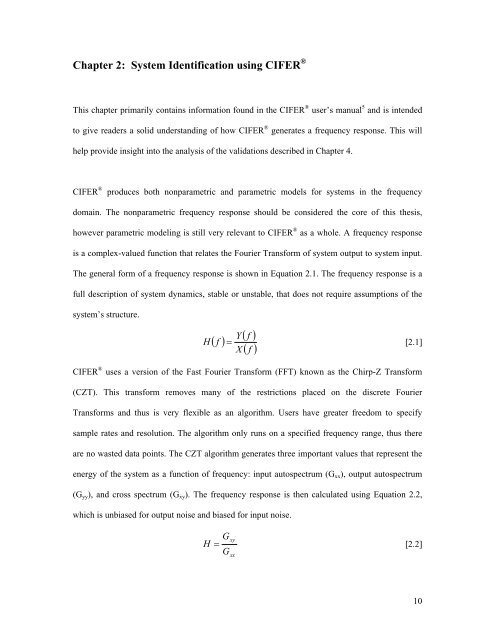CIFER®-MATLAB Interfaces: Development and ... - Cal Poly
CIFER®-MATLAB Interfaces: Development and ... - Cal Poly
CIFER®-MATLAB Interfaces: Development and ... - Cal Poly
You also want an ePaper? Increase the reach of your titles
YUMPU automatically turns print PDFs into web optimized ePapers that Google loves.
Chapter 2: System Identification using CIFER ®<br />
This chapter primarily contains information found in the CIFER ® user’s manual 5 <strong>and</strong> is intended<br />
to give readers a solid underst<strong>and</strong>ing of how CIFER ® generates a frequency response. This will<br />
help provide insight into the analysis of the validations described in Chapter 4.<br />
CIFER ®<br />
produces both nonparametric <strong>and</strong> parametric models for systems in the frequency<br />
domain. The nonparametric frequency response should be considered the core of this thesis,<br />
however parametric modeling is still very relevant to CIFER ® as a whole. A frequency response<br />
is a complex-valued function that relates the Fourier Transform of system output to system input.<br />
The general form of a frequency response is shown in Equation 2.1. The frequency response is a<br />
full description of system dynamics, stable or unstable, that does not require assumptions of the<br />
system’s structure.<br />
( f )<br />
( f )<br />
Y<br />
H ( f ) = [2.1]<br />
X<br />
CIFER ® uses a version of the Fast Fourier Transform (FFT) known as the Chirp-Z Transform<br />
(CZT). This transform removes many of the restrictions placed on the discrete Fourier<br />
Transforms <strong>and</strong> thus is very flexible as an algorithm. Users have greater freedom to specify<br />
sample rates <strong>and</strong> resolution. The algorithm only runs on a specified frequency range, thus there<br />
are no wasted data points. The CZT algorithm generates three important values that represent the<br />
energy of the system as a function of frequency: input autospectrum (G xx ), output autospectrum<br />
(G yy ), <strong>and</strong> cross spectrum (G xy ). The frequency response is then calculated using Equation 2.2,<br />
which is unbiased for output noise <strong>and</strong> biased for input noise.<br />
Gxy<br />
H = [2.2]<br />
G<br />
xx<br />
10













